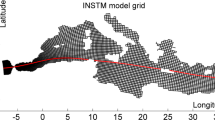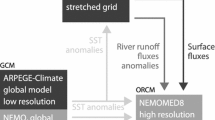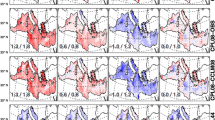Abstract
A scenario of the Mediterranean Sea is performed for the twenty-first century based on an ocean modelling approach. A climate change IPCC-A2 scenario run with an atmosphere regional climate model is used to force a Mediterranean Sea high-resolution ocean model over the 1960–2099 period. For comparison, a control simulation as long as the scenario has also been carried out under present climate fluxes. This control run shows air–sea fluxes in agreement with observations, stable temperature and salinity characteristics and a realistic thermohaline circulation simulating the different intermediate and deep water masses described in the literature. During the scenario, warming and saltening are simulated for the surface (+3.1°C and + 0.48 psu for the Mediterranean Sea at the end of the twenty-first century) and for the deeper layers (+1.5°C and + 0.23 psu on average). These simulated trends are in agreement with observed trends for the Mediterranean Sea over the last decades. In addition, the Mediterranean thermohaline circulation (MTHC) is strongly weakened at the end of the twenty-first century. This behaviour is mainly due to the decrease in surface density and so the decrease in winter deep-water formation. At the end of the twenty-first century, the MTHC weakening can be evaluated as −40% for the intermediate waters and −80% for the deep circulation with respect to present-climate conditions. The characteristics of the Mediterranean Outflow Waters flowing into the Atlantic Ocean are also strongly influenced during the scenario.














Similar content being viewed by others
References
Arakawa A (1972) Design of UCLA general circulation model. University of California, no. 7, 116 pp
Artegiani A, Bregant D, Paschini E, Pinardi N, Raicich F, Russo A (1997) The Adriatic Sea general circulation, Part I air–sea interactions and water mass structure. J Phys Oceanogr 27:1492–1514
Barnier B, Siefridt L, Marchesiello P (1995) Thermal forcing for a global ocean circulation model using a three year climatology of ECMWF analyses. J Mar Syst 6(4):363–380
Béranger K, Mortier L, Gasparini G, Gervasio L, Astraldi M, Crépon M (2004) The dynamic of the Sicily Strait: a comprehensive study from observations and models. Deep Sea Res II 51(4–5):411–440
Béthoux JP (1979) Budgets of the Mediterranean Sea. Their dependence on the local climate and on the characteristics of the Atlantic waters. Oceanol Acta 2:157–163
Béthoux JP, Gentili B, Raunet J, Tailliez D (1990) Warming trend in the western Mediterranean deep water. Nature 347:660–662
Béthoux JP (1993) Mediterranean sapropel formation, dynamic and climatic viewpoints. Oceanologica Acta 16:127–133
Béthoux JP, Gentili B, Tailliez D (1998) Warming and freshwater budget change in the Mediterranean since the 1940s, their possible relation to the greenhouse effect. Geophys Res Lett 25(7):1023–1026
Blanke B, Delecluse P (1993) Variability of the tropical Atlantic ocean simulated by a general circulation model with two different mixed layer physics. J Phys Oceanogr 23:1363–1388
Brankart J, Pinardi N (2001) Abrupt cooling of the Mediterranean Levantine intermediate water at the beginning of the 1980s: observational evidence and model simulation. J Phys Oceanogr 31:2307–2320
Bryden H, Kinder T (1991) Steady two-layer exchange through the Strait of Gibraltar. Deep Sea Res 38:S445–S463
Bunker A, Charnock H, Goldsmith R (1982) A note on the heat balance of the Mediterranean and Red Seas. J Mar Res 40:73–84
Canuto V, Howard A, Hogan P, Cheng Y, Dubovikov M, Montenegro L (2004) Modeling ocean convection. Ocean Model 7:75–95
Castellari S, Pinardi N, Leaman K (2000) Simulation of the water mass formation processes in the Mediterranean Sea, influence of the time frequency of the atmospheric forcing. J Geophys Res 105(C10):24157–24181
Chanut J (2003) Paramétrisation de la restratification après convection profonde en mer du Labrador(in French). PhD thesis, Université Joseph Fourier, Grenoble, p 185
Christensen JH, Carter TR, Giorgi F (2002) PRUDENCE employs new methods to assess European climate change. EOS 83:147
Cubasch U, Waszkewitz J, Hegerl G, Perlwitz J (1995) Regional climate changes as simulated in time-slice experiments. Clim Change 31:273–304
Curry R, Dickson B, Yashayaev I (2003) A change in the freshwater balance of the Atlantic Ocean over the past four decades. Nature 426(6968):826–828
da Silva A, Young C, Levitus S (1994) Atlas of surface marine data. Algorithms and Procedure, NOAA Atlas Series 1, 74 pp, Natl Oceanic and Atmos Admin, Silver Spring
Déqué M, Dreveton C, Braun A, Cariolle D (1994) The ARPEGE-IFS atmosphere model, a contribution to the French community climate modelling. Clim Dyn 10:249–266
Déqué M, Piedelievre JP (1995) High-resolution climate simulation over Europe. Clim Dyn 11:321–339
Döös K, Meier M, Döscher R (2004) The Baltic haline conveyor belt or the overturning circulation and micing in the Baltic. Ambio 33(4–5):261–266
Douville H, Planton S, Royer JF, Stephenson DB, Tyteca S, Kergoat L, Lafont S, Betts RA (2000) The importance of vegetation feedbacks in doubled-CO2 time-slice experiments. J Geophys Res 105:14841–14861
Douville H, Chauvin F, Royer JF, Salas-Mélia D, Tyteca S (2002) Sensitivity of the hydrological cycle to increasing amounts of greenhouse gases and aerosols. Clim Dyn 20:45–68
Drillet Y, Bourdallé-Badie R, Siefridt L, Le Provost C (2005) The MEDDIES in the Mercator North Atlantic and Mediterranean Sea eddy-resolving model. J Geophys Res 110(C03016). DOI:10.1029/2003JC002170
Frei C, Christensen JH, Déqué M, Jacob D, Jones RG, Vidale PL (2003). Daily precipitation statistics in regional climate models: evaluation and intercomparison for the European Alps. J Geophys Res 108:ACL9119
Fuda JL, Etiope G, Millot C, Favali P, Calcara M, Smirglio G, Boschi E (2002) Warming, salting and origin of the Tyrrhenian Deep Water. Geo Res Lett 29(19):4-1–4-4
Garrett C (1996) The role of the strait of Gibraltar in the evolution of the Mediterranean water, poperties and circulation. Bulletin de l’Institut Océanographique de Monaco 17:1–19
Gibelin AL, Déqué M (2003) Anthropogenic climate change over the Mediterranean region simulated by a global variable resolution model. Clim Dyn 20:327–339
Gibson JK, Kållberg P, Uppala S, Hernandez A, Serano E (1997) ERA description, ECMWF Re-analysis project report series. ECMWF, Shinfield Park, Reading
Gilman C, Garrett C (1994) Heat flux parameterizations for the Mediterranean Sea: the role of atmospheric aerosols and constraints from the water budget. J Geophys Res 99:5119–5134
Giorgi F, Mearns LO (1999) Regional climate modeling revisited. An introduction to the special issue. J Geophys Res 104:6335–6352
Hagemann S, Machenhauer B, Jones RG, Christensen OB, Déqué M, Jacob D, Vidale PL (2004) Evaluation of water and energy budgets in regional climate models applied over Europe. Clim Dyn 23:547–567
Huang RX (1993) Real freshwater flux as a natural boundary condition for the salinity balance and thermohaline circulation forced by evaporation and precipitation. J Phys Oceano 23:2428–2446
IPCC (2001) Climate Change 2001. The scientific basis. In: Houghton JT, Ding Y, Griggs DJ, Noguer M, Van der Linder PJ, Dai X, Maskell K, Johnson CA (Eds) Contribution of working group I to the third assessment report of the IPCC. Cambridge University Press, Cambridge, 881 pp
Jackett DR, McDougall TJ (1995) Minimal adjustment of hydrographic data to achieve static stability. J Atmos Ocean Techol 12:381–389
Josey S, Kent E, Taylor P (1999) New insights into the ocean heat budget closure problem from analysis of the SOC air–sea flux climatology. J Clim 12:2856–2880
Josey S (2003) Changes in the heat and freshwater forcing of the eastern Mediterranean and their influence on deep water formation. J Geophys Res 108(C7):30-1–30-18
Kistler R et al (2001) The NCEP-NCAR 50-year reanalysis: monthly means CD-ROM and documentation. Bull Am Meteorol Soc 82:247–267
Klein B, Roether W, Manca B, Bregant D, Beitzel V, Kovacevic V, Luchetta A (1999) The large deep water transient in the Eastern Mediterranean. Deep Sea Res Part I 46:371–414
Klein B, Roether W, Kress N, Manca B, Ribera D’Alcala M, Souvermezoglou E, Theocharis A, Civitarese G, Luchetta A (2003) Accelerated oxygen consumption in eastern Mediterranean deep waters following the recent changes in thermohaline circulation. J Geophys Res 108(C9):8-1(8107)
Klinger, Marshall J, Send U (1996) Representation of convective plumes by vertical adjustment. J Geophys Res 101:18175–18182
Korres G, Pinardi N, Lascaratos A (2000) The ocean response to low frequency interannual atmospheric variability in the Mediterranean sea, Part I Sensitivity experiments and energy analysis. J Clim 13:705–731
Lascaratos A (1993) Estimation of deep and intermediate water mass formation rates in the Mediterranean Sea. Deep Sea Res II 40(6):1327–1332
Lascaratos A, Williams R, Tragou E (1993) A mixed-layer study of the formation of Levantine intermediate water. J Geophys Res 98:14739–14749
Lascaratos A, Roether W, Nittis K, Klein B (1999) Recent changes in deep water formation and spreading in the Eastern Mediterranean Sea: a review. Prog Oceanogr 44:5–36
Macdonald A, Candela J, Bryden H (1994) An estimate of the net heat transport through the Strait of Gibraltar. In: La Violette PE (ed) Seasonal and interannual variability of the Western Mediterranean Sea, Coastal Estuarine Studies, 46, Amer. Geophys. Union 13–32
Machenhauer B, Windelband M, Botzet M, Christensen JH, Déqué M, Jones J, Ruti PM, Visconti G (1998) Validation and analysis of regional present-day climate and climate change simulations over Europe. MPI Report No 275, MPI, Hamburg, p 87
Madec G (1990) La formation d’eau profonde et son impact sur la circulation régionale en Méditerranée occidentale une approche numérique (in french). PhD thesis, Université Paris VI, p 193
Madec G, Chartier M, Crépon M (1991a) The effect of thermohaline forcing variability on deep water formation in the western Mediterranean sea a high resolution three dimensional numerical study. Dyn Atmos Ocean 15:301–332
Madec G, Chartier M, Delecluse P, Crépon M (1991b) A three dimensional numerical study of deep water formation in the northwestern Mediterranean sea. J Phys Oceanogr 21(9):1349–1371
Madec G, Lott F, Delecluse P, Crépon M (1996) Large-scale preconditioning of deep-water formation in the northwestern Mediterranean sea. J Phys Oceanogr 26:1393–1408
Madec G, Delecluse P, Imbard M, Levy C (1998) OPA 8.1, Ocean general circulation model, reference manual. IPSL/LODYC, France, Note du Pôle de modélisation, 11
Manabe S, Stouffer R (1999) The role of the thermohaline circulation in climate. Tellus 51:91–109
Manca B, Budillon G, Scarazzato P, Ursella L (2003) Evolution of dynamics in the eastern Mediterranean affecting water mass structures and properties in the Ionian and Adriatic Seas. J Geophys Res 108(C9):8102
Marshall J, Schott F (1999) Open-ocean convection: observations, theory, and models. Rev Geophys 37:1–64
Matthiesen S and Haines K (2003) A hydraulic box study of the Mediterranean response to postglacial sea level rise. Paleooceano 18(4):8-1–8-12(1084)
MEDAR/MEDATLAS Group (2002) MEDAR/MEDATLAS 2002 Database. Cruise inventory, observed and analyzed data of temperature and bio-chemical parameters, 4 Cdrom
MEDOC Group (1970) Observations of formation of deep-water in the Mediterranean Sea. Nature 227:1037–1040
Mertens C, Schott F (1998) Interannual variability of deep-water formation in the Northwestern Mediterranean. J Phys Oceanogr 28:1410–1424
Myers P, Haines K, Rohling E (1998) Modeling the paleocirculation of the Mediterranean, The last glacial maximum and the holocene with emphasis on the formation of sapropel S1. Paleooceano 13(6):586–606
Myers P, Haines K (2000) Seasonal and interannual variability in a model of the mediterranean under derived flux forcing. J Phys Oceanogr 30:1069–1082
Myers P, Haines K (2002) Stability of the Mediterranean’s thermohaline circulation under modified surface evaporative fluxes. J Geophys Res 107(C3). DOI:10.1029/2000JC000550
New M, Hulme M, Jones PD (1999) Representing twentieth century space-time climate variability, Part 1 development of a 1961–90 mean monthly terrestrial limatology. J Clim 12:829–856
Nittis K, Lascaratos A, Theocharis A (2003) Dense water formation in the Aegean Sea numerical simulations during the Eastern Mediterranean Transient. J Geophys Res 108(C9). DOI:10.1029/2002JC001352
Ozsoy E, Hecht A, Unluata U, Brenner S, Sur H, Bishop J, Latif M, Rozentraub Z, Oguz T (1993) A synthesis of the Levantine basin circulation and hydrography, 1985–1990. Deep Sea Res Part II 40:1075–1119
Pickard G, Emery W (1994) Descriptive physical oceanography: an introduction, 5th edn. Pergamon, New York
Potter R and Lozier S (2004) On the warming and salinification of the Mediterranean outflow waters in the North Atlantic. Geophys Res Lett 31:L01202. DOI:10.1029/2003GL018161
Reid JL (1979) On the contribution of the Mediterranean Sea outflow to the Norwegian-Greenland Sea. Deep Sea Res Part A 26:1199–1223
Reynaud T, LeGrand P, Mercier H, Barnier B (1998) A new analysis of hydrographic data in the Atlantic and its application to an inverse modeling study. Int WOCE Newslett 32:29–31
Roether W, Manca B, Klein B, Bregant D, Georgopoulos D, Beitzel W, Kovacevic V, Luchetta A (1996) Recent changes in Eastern Mediterranean Deep Waters. Science 271:333–334
Rohling E, Bryden H (1992) Man-induced salinity and temperature increases in Western Mediterranean Deep Water. J Geophys Res 97(C7):11191–11198
Roullet G, Madec G (2000) Salt conservation, free surface, and varying levels: a new formulation for ocean general circulation models. J Geophys Res 105:23927–23942
Royer JF, Cariolle D, Chauvin F, Déqué M, Douville H, Planton S, Rascol A, Ricard JL, Salas y Melia D, Sevault F, Simon P, Somot S, Tyteca S, Terray L, Valcke S (2002) Simulation of climate changes during the 21-st century including stratospheric ozone. Géosciences 334(3):147–154
Rupolo V, Marullo S, Iudicone D (2003) Eastern Mediterranean Transient studied with Lagrangian diagnostics applied to a Mediterranean OGCM forced by satellite SST and ECMWF wind stress for the years 1988–1993. J Geophys Res 108(C9):8121. DOI:10.1029/2002JC001403
Schott F, Visbeck M, Send U, Fisher J, Stramma L, Desaubies Y (1996) Observations of deep convection in the Gulf of Lions, northern Mediterranean, during the winter of 1991/1992. J Phys Oceanogr 26:505–524
Sevault F, Somot S, Déqué M (2002) Couplage ARPEGE-MEDIAS-OPA-MEDITERANEE. Les étapes, Note de Centre, CNRM, GMGEC, n. 84 (in french, available at samuel.somot@meteo.fr)
Smith T, Reynolds R, Livezey R, Stokes D (1996) Reconstruction of historical sea surface temperatures using empirical orthogonal functions. J Clim 9:1403–1420
Smith W, Sandwell D (1997) Global sea floor topography from satellite altimetry and ship depth sounding. Sciences 277(5334):1956–1962
Somot (2005) Modélisation climatique du bassin méditerranéen variabilité et scénarios de changement climatique. PhD thesis, Univ. Paul Sabatier, Toulouse, p 333
Somot S, Sevault F (2005) Climate change impact on the Mediterranean Sea circulation: a regional modelling approach. Note de Centre du CNRM, GMGEC 95, internal report (available at samuel.somot@meteo.fr)
Speer K, Tziperman E (1992) Rates of water mass formation in the North Atlantic Ocean. J Phys Oceanogr 22:93–104
Stanev E, Le Traon P-Y, Peneva E (2000) Sea level variations and their dependency on meteorological and hydrological forcing: analysis of altimeter and surface data for the Black Sea. J Geophys Res 105(C7):17203–17216
Stocker T, Schmittner A (1997) Influence of CO2 emission rates on the stability of the thermohaline circulation. Nature 388:862–865
Stratford K, Haines K (2000) Frictional sinking of the dense water overflow in a z-coordinate OGCM of the Mediterranean Sea. Geophys Res Lett 27(24):3969–3972
Thorpe RB, Bigg GR (2000) Modelling the sensitivity of Mediterranean Outflow to anthropogenically forced climate change. Clim Dyn 16:355–368
Tziperman E (1986) On the role of interior mixing and air–sea fluxes in determining the stratification and circulation of the oceans. J Phys Oceanogr 16:680–693
Tziperman E,Speer K (1994) A study of water mass transformation in the Mediterranean Sea, analysis of climatological data and a simple three-box model. Dyn Atmos Ocean 21:53–82
Valcke S, Terray L, Piacentini A (2000) OASIS 2.4 Ocean Atmosphere Sea Ice Soil. User’s Guide, CERFACS
Vellinga M, Wood R (2002) Global climatic impacts of a collapse of the Atlantic thermohaline circulation. Clim Change 54(3):251–267
Vörösmarty C, Fekete B, Tucker B (1996) Global river discharge database, RivDis, vol. 0–7. International Hydrological Program, Global Hydrological Archive and Analysis Systems, UNESCO, Paris
Walin G (1982) On the relation between sea-surface heat flow and the thermal circulation in the ocean. Tellus 34:187–195
Wilby RL, Wigley TML, Conway D, Jones PD, Hewitson BC, Main J, Wilks DS (1998) Statistical downscaling of general circulation model output, A comparison of methods. Water Resour Res 34:2995–3008
Wu P, Haines K (1996) Modelling the dipersal of Levantine Intermediate Water and its role in Mediterranean deep water formation. J Geophys Res 101:6591–6607
Wu P, Haines K (1998) The general circulation of the Mediterranean Sea from a 100-year simulation. J Geophys Res 103(C1):1121–1135
Wüst G (1961) On the vertical circulation of the Mediterranean Sea. J Geophys res 66(10):3261–3271
Acknowledgments
This work was supported by the European Union Program Energy, Environment and Sustainable Development under contract EVK2–2001–00156 (PRUDENCE) and by the GICC-MedWater program of the Ministère de l’Ecologie et du Développement Durable (French Environment Ministry). We also thank Dr. Michel Crépon, Dr Bernard Barnier and Dr Gurvan Madec for helpful comments and suggestions.
Author information
Authors and Affiliations
Corresponding author
Rights and permissions
About this article
Cite this article
Somot, S., Sevault, F. & Déqué, M. Transient climate change scenario simulation of the Mediterranean Sea for the twenty-first century using a high-resolution ocean circulation model. Clim Dyn 27, 851–879 (2006). https://doi.org/10.1007/s00382-006-0167-z
Received:
Accepted:
Published:
Issue Date:
DOI: https://doi.org/10.1007/s00382-006-0167-z




